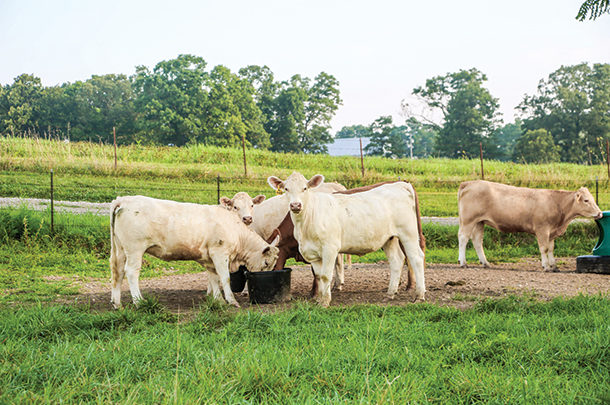Did you know there is a difference between economics and finance? If you are not familiar with the distinction, here it is in simple terms: Economics is about whether we should do something, and finance is about whether we can do something. Economics is figuring out whether an investment generates a return. Finance is figuring out how to actually make the investment. Economics is about profitability. Finance is about cash flow.
When it comes to reproductive management of commercial cattle, both economics and finance factor into our decision-making. Whether we are developing replacement heifers, culling cows, using estrous synchronization, performing artificial insemination (A.I.), purchasing bulls or investing in products or services, we really are making decisions with both a short-term and a long-term horizon. The farm or ranch needs to be profitable in the long term – increasingly profitable, ideally. And the actions of the farm or ranch also have to cash flow. We have to survive today in order to get to a more profitable tomorrow.
But I am convinced most of us in the commercial cow-calf world have not thought through reproductive management with long-term profitability in mind. Instead, we often think only about cash flow. We ask questions like, “Can I afford the cost of A.I.?” It is a fair question when considering the cost of any technology. But it is a cash flow question, and cash flow is only part of what we need to consider.
Typical production models
Short-term focus is a problem that is not unique to reproductive management. In the farming and ranching world, we see all sorts of horrible business strategies cash flowed when they are not actually profitable. Often, this is done by ignoring non-cash costs, like depreciation or deferred maintenance of equipment, buildings or other facilities. Poorly profitable business strategies are also often subsidized by our donated labor or the rent-free use of owned land. These are dangerous games. When business activities cash flow but do not turn a true profit, we can easily wind up “eating our equity.”
Most commercial cow-calf budgets available from extension tell a sobering story this year. Commercial cow-calf margins are projected to be negative for the year, even before overhead costs of the farm or ranch are included. That means cow-calf enterprises with typical production models will not turn a true profit and will likely also be difficult to even cash flow. Maybe that is a signal to get out of the cow-calf enterprise. But maybe it is just a signal to get out of the typical cow-calf production model.
I will offer three ideas – ideas that can cash flow – to improve the profitability of a commercial cow-calf enterprise through reproductive management.
1. Market cows more proactively
Rather than culling cows simply because they fail to become pregnant, fail to have a calf, have bad teeth or are lame, consider a more proactive marketing strategy. Cattle begin to decline in value fairly rapidly after the age of 5 or so, and we would do well to identify the poorly profitable cows and market them before they reach this age. I strongly encourage having a pregnancy diagnosis performed relatively early (e.g., 75 to 100 days after the start of the breeding period) and marketing cows that conceived late. This allows you to capture the value of poorly productive females when they are at their most valuable age and can be marketed as pregnant.
This is an especially advantageous strategy if it allows you to reduce your stocking rate going into months when cow carrying costs are generally highest (e.g., winter). Aside from being a cost-reduction strategy to manage both feed costs and hidden costs of cow depreciation, this is also a strategy to maximize gross profit margin per cow. By retaining early conceiving cows, we retain early calving cows that will wean older and therefore heavier calves. These cows will also have the greatest potential to conceive early in the next breeding season and therefore have greater lifetime profit potential.
2. Rethink selection of replacement heifers
Most of us are selecting heifers at the wrong time (i.e., weaning). For long-term profitability, that needs to change. Although screening heifers at weaning is appropriate, heifer selection really cannot occur until it is clear which heifers have become pregnant very early in the breeding season. If you are having problems with reproductive performance of 2-year-old and 3-year-old cows, it is very likely this has something to do with retaining heifers that conceived late in their first breeding season.
Most commercial cattle operations develop too few heifers relative to the number of replacements the cow-calf enterprise will require. When we do that, we are inclined to use a long breeding period and to keep every heifer that becomes pregnant. That is a mistake. Run the numbers for developing a much larger proportion of your heifer calf crop and using a very short breeding period. It may make more sense to develop heifers to a slightly lighter pre-breeding weight as long as it can be done cost-effectively while still allowing heifers to reach puberty. If you can put post-weaning weight gain on heifers at a reasonable cost, the value of that gain may result in profit margin even on open heifers marketed as feeder calves.
3. Front-load the calving distribution with synchronization
Although you will find no bigger advocate than me when it comes to the value of A.I., estrous synchronization can be a great tool even when used with natural service. Since you likely already own the bulls and the product costs of these systems are moderate, synchronization with natural service is easy to cash flow. More importantly, it can offer tremendous benefits in increased revenue.
These protocols give cows or heifers an opportunity to conceive earlier in the breeding period. This can also increase the average number of opportunities a cow has to conceive within a short, defined breeding season. The end result is a front-loaded distribution of when calves are born, resulting in older and therefore heavier calves at weaning. Even better, use of synchronization to front-load the calving season leaves cows having more time after calving before the start of the next breeding season.
Long-term profit potential
Any of these three suggestions can improve the economic or financial position of the farm or ranch in year one. But the real exciting improvements come as the operation begins to use multiple strategies and does so for successive years. There is a lot of long-term profit potential down that path, and figuring out how to cash flow the first steps is well worth it.











